Moving Fish to a New Tank Updated
Moving Fish to a New Tank
How to motion a mature, fully stocked aquarium is asked many, many times on the forums and it scares a lot of aquarium owners, only there are times when we need to movement home, renovate the room or install new flooring and the aquarium has to be moved.
While working every bit an aquarium maintenance technician I moved a lot of aquariums for owners who did not know how to practice it or were too scared.
Moving an aquarium is pretty straightforward once y'all know the steps and brand a program.
Never movement an aquarium with water in it! A plan and people to help make the move much easier. Transport livestock in a split heated container and ensure 10% of the old tank h2o and gets moved also. New water should exist heated and match the old tank water before re-calculation livestock.
Using my experience of moving many aquariums safely I wanted to create this article to help you make a plan for when you next need to move your pride and joy!
This article is mainly focused on moving a saltwater aquarium with fish, invertebrates, and coral just many of the steps apply to freshwater aquariums, but ignore the salty $.25!
Are There Dissimilar Types of Aquarium Movement?
There are three principal types of aquarium movement and each has its own plan that need to be created:
- Temporary aquarium move for a change of flooring or location to a new room inside the aforementioned building
- Moving to a new house within a couple of hours bulldoze
- Moving to a new firm beyond the country or many hours drive away
As you tin can imagine, the further the aquarium has to be moved the more thorough the plan has to be to ensure the move is completed safely.
Aquarium Move Planning
This is the function that can make a tank move easy and stress-free or the worst day of your life! Depending on the distance you are moving, will depend on when y'all need to outset thinking of your plan. You demand to sit down down and start writing down every idea that you tin recollect of about your tank move. Just brainstorm, no thought is useless at this signal.
Spend a few days making this list. New ideas may pop into your head and you need to just make a note and add them to the brainstorm. Ask friends and family to retrieve of ideas. They may have a different view to you lot and suggest some really good things you may not have realized.

No matter the distance the aquarium is moving, the plan stays the aforementioned, simply the details of the program will change. Once y'all take your brainstorm, start to try and layout the ideas in a logical order post-obit this timeline:
- One month before the move
- Two weeks before the motility
- One week before the movement
- The day before the move
- The solar day of the movement
- The day later the move
- The week after the movement
- Two weeks after the movement
This will first to give you an idea of what needs to be washed and when so you don't forget anything. This will also let you lot to allocate the correct amount of time to each task. Don't forget to add in buffer time!
Lets look at each type of movement to run across what needs to be planned:
This is a long, detailed article with some steps repeated in each section where applicable, and so if y'all want to jump to the section near relevant to you lot click on the heading below:
— Temporary Aquarium Motion – See Below —
— Moving An Aquarium Within a Few Hours Drive – Click Hither —
— Moving An Aquarium Across the Country – Click Here —
Temporary Aquarium Move

When new flooring is required, renos are wanting to be completed or the aquarium needs to be located to another room is when the simplest plan is required.
When this type of move occurs, the aquarium, all its equipment, and its livestock will be going dorsum just as it was before the movement so its more than a example of having a temporary home for the livestock and a plan on what to motility and when.
I had to do this to my own aquarium when I was in my early on 20'due south every bit my parents wanted a new carpeting fitted – I can tell yous that information technology was nearly a 24 hr process so exist prepared for a long solar day! Since then I have learned many tips and techniques that drastically improved the moves!
One to 2 Weeks Before Moving Day
- Confirm the exact day for the motility, ensure the contractors (or whoever is making y'all move the tank) are booked for the same day!
- If additional assist is required get asking – family, friends and local aquarists are all great.
1 Tip is that fifty-fifty empty aquariums are heavy – Make sure you have plenty bodies to carry the aquarium.
75G Glass Tank = 100lbs Crude Empty Weight
120G Glass Tank = 190lbs Crude Empty Weight
210G Glass Tank = 350lbs Rough Empty Weight
You tin rent suction cups and dollies from most Tool Rental Stores
- Begin to assemble your supplies:-
- Rubbermaid Totes & Bins are great for livestock storage
- Clean all storage totes and bins thoroughly!
- Obtain a heater and pocket-size powerhead for each tote/bin
- A digital thermometer for each storage tote/bin – Relieves your anxiety!
- Dr. Tims One and Only Nitrifying Leaner Culture – Here at Amazon.com (Fresh & Saltwater Versions)
- Ammonia, Nitrite and Nitrate Exam Kits – I recommend Salifert – Here at Amazon.com
- Get some large fish nets – Makes catching fish so much easier!
- Build a frame to hang lights over coral totes if its a reef tank
- Ensure your totes are large enough for the corporeality of livestock you have
- Collect old towels & Cardboard to walk on – Yous will use lots!
- Collect salt or RO/DI water ready for the move
- Collect empty table salt buckets or new five gallon pails from a hardware store – Make clean thoroughly
- If you are planning whatever aquarium or equipment upgrades, ensure yous take all the supplies and new gear
- If whatever specialist tools, adhesives, or sealants are required ensure you have them all
Three Days Earlier Moving Day
- Confirm with the contractors over again and confirm they are showing up at the right fourth dimension!
- Ostend your help is still available!
- Stop feeding the livestock
- Give the sandbed/gravel a really skilful vacuum, blast the rocks with a turkey baster and exercise a good 25% h2o modify
- Ensure the new/temporary location is ready and the area is clear betwixt the two locations
- Assemble all your moving supplies into the locations they need to exist at
- Test all the pumps and heaters to ensure they work and they concur the right temperature
The Solar day Before Moving Day
- Make upwardly enough water for a 50% water change. Store in a Rubbermaid bin. Ensure the h2o is heated to the correct temp, salinity is correct (if required), and moving with pump and heater.
- Ensure this bin is not in the way! Trust me I fabricated that mistake once!
- Brainstorm to move every bit much of the equipment that is not required every bit you can:
- Food
- Medications
- Maintenance tools – Keep these handy
- Get all the tools required close by
- Have a practiced dinner and get a adept night's slumber! Tomorrow could exist a long twenty-four hour period!
On Moving 24-hour interval
- Get up early and accept a good breakfast!
- Check all your temporary storage bins are ready to go
- Ensure the new h2o is mixed and up to temperature
- Lay out cardboard on the floor and cover it with the onetime towels everywhere you lot plan to walk
- Begin to remove approx l% of the water into a storage tote that is out of the style. This is for your livestock containers! A Python Vacuum is great for this as it has a long hose
You can observe ane Hither at Amazon.com
One Tip is to ensure at that place is a person on each end of the hose! Hoses pop out of containers very easily!
- Remove all the ornaments or Live Stone and Coral and identify them into a container with some of the aquarium water yous just removed
- Install heater, pump, thermometer
- If its coral, get the lights moved onto their temporary frame and ensure the calorie-free schedule remains as it was – Pass up the light intensity 50% to prevent bleaching or place them higher
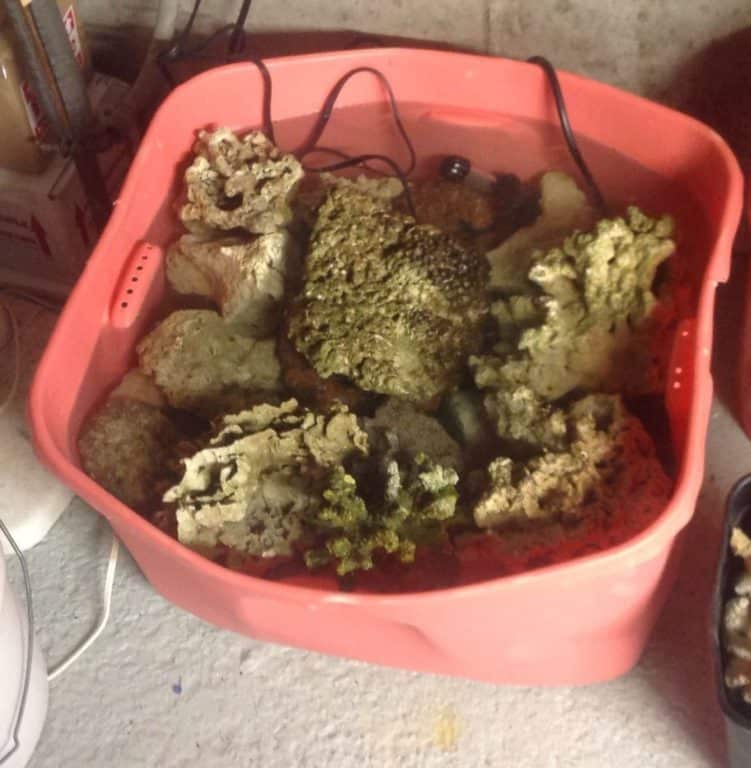
- Endeavor to begin catching fish and invertebrates at present at that place is zero merely water and substrate in the aquarium
- Transfer them to containers with some of the old aquarium water
- Install heater, pump, thermometer
- Ensure the livestock that is in the totes can tolerate each other – Utilize the chart below if it is a saltwater aquarium:
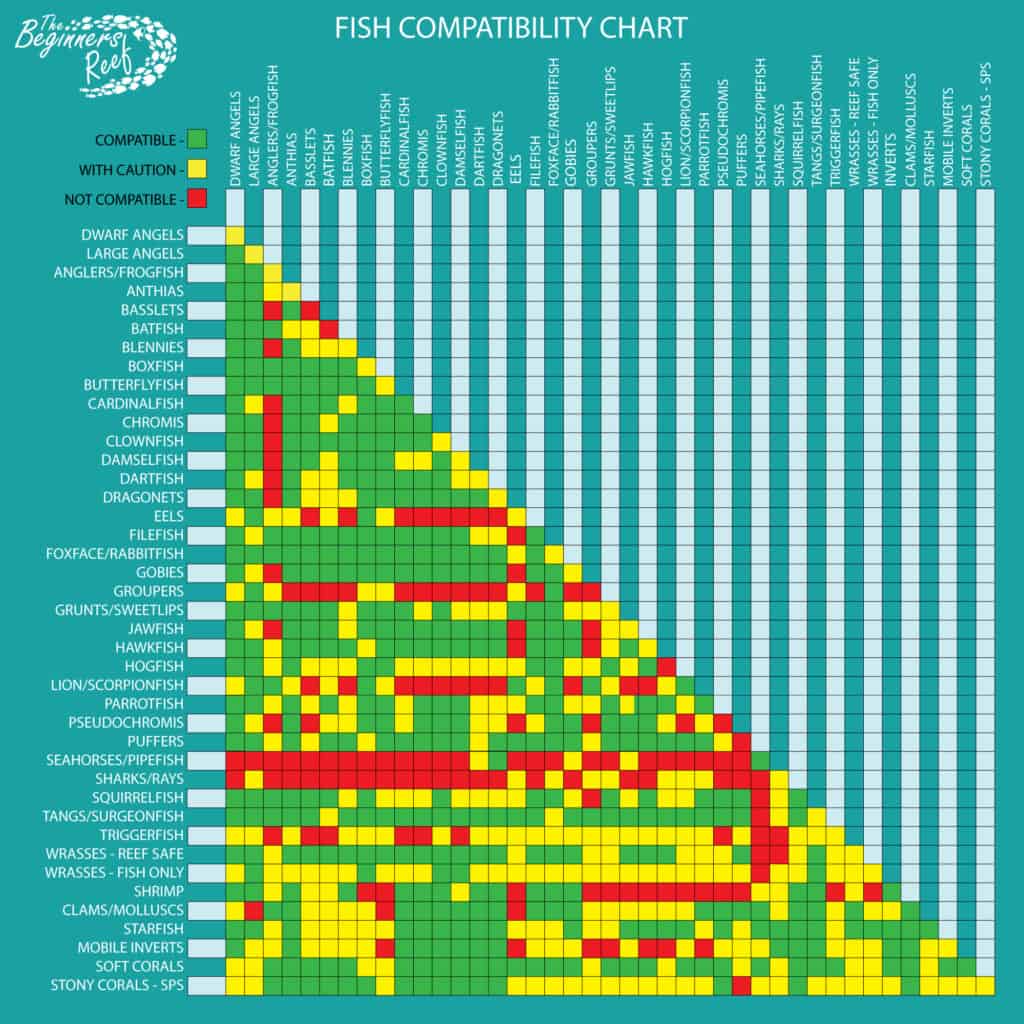
- Remove all remaining water from the aquarium – NEVER move an aquarium with water in information technology. The dynamic loads could crevice the tank or impose loads on that could allow information technology to burst in the hereafter!
- If the sand bed is over three inches deep remove information technology and dispose of it as the bacteria and matter stored deep within it will foul the second its all removed and mixed together
- If the sand bed is under 3 inches deep remove the sand or gravel and identify information technology in a bin with water, a pump, and a heater. This will aid preserve the beneficial nitrifying bacteria living inside the sand
- Remove all the filtration and place in a storage container with old tank water
- Install heater and a pump
- This ensures that all the beneficial nitrifying bacteria living in the filter media will survive the motion ready for when we need them at re-installation!
- Ensure the areas and walkways are articulate of tools and equipment
- Motility the aquarium, stand, and whatever additional equipment well out of the way
During The Moving Day
- Once all the room is vacated, ensure no dust or contractor mess can piece of work its way to your aquatic property area. Tape up the door seams etc
- At present its time for some chores while the contractors do their piece of work:
- Ensure regular spot checks of all the storage totes for temperature, salinity (if required), and livestock
- Clean all the equipment with some old aquarium water then its like new when its re-installation time – DO NOT use make clean tap water to wash filter media – Yous Will Kill the benign nitrifying leaner!
- Take a break when you tin can – Exercise Not Take A BEER! – Just yet. You demand your head clear!
- Order in pizza for your helpers and relax while you can!
Re-Installation
One time you accept the room back and everything has stale, its fourth dimension to start getting the aquarium dorsum together.
- Become the aquarium and stand installed and ensure it is perfectly level
- Get all plumbing connected and electrical extension cords etc neatly secured
- Begin to reinstall your aquascape with your Live Rock while placing in the substrate – Always identify your rocks on the drinking glass and not on the substrate
If you require new substrate you can observe a actually overnice selection Here at Amazon.com. Here is also a handy sandbed reckoner then y'all know how much to get. You can notice the estimator Here
- Brainstorm to fill the aquarium with the water y'all start removed from the aquarium and stored in a container – Heated and moving with a pump
- As your aquarium begins to fill and covers all the equipment y'all tin can commencement to burn down up the filtration and leak check
- Fill 50% of the aquarium with old water and have the other 50% with the new h2o you had previously made and heated ready
One Tip is to slowly pour/pump your old tank water through a filter sock and onto a dinner plate/saucer equally it goes back into the aquarium. This volition help remove any sediment from when information technology was first removed and keep sediment from existence stirred up.
- Once you are sure there are no leaks, completely fill the arrangement
- Run all the pumps, filters, and wavemakers to ensure everything is running every bit information technology should
- If you accept media reactors installed, leave them empty for today to allow the mechanical filter to remove the suspended sediment
- Check all the water parameters earlier adding your livestock
Because your livestock are going into a new environment I highly advise you lot acclimate them just like you did when you bought them home for the first time.
If you demand any tips on fish acclimation check out this article. Information technology works for freshwater besides, but leave out the salt parts:
How To Acclimatize Saltwater Fish
- Brainstorm to slowly acclimate each fish over 30 minutes and add your livestock with the most aggressive and territorial fish going in terminal
- Reinstall the lights and awning and leave the lights off for the rest of the day
- Practice not feed the fish
- Add together in a recommended dose of Dr. Tims One and Just – This volition assist boost the growth of the nitrifying leaner. Yous tin find information technology Here at Amazon.com in both fresh & saltwater versions
- Have a thorough inspection of all the equipment, pipes, connections, and cables to ensure everything is working perfectly
Fire upward the grill and give all your helpers a well-earned steak and a few cold ones!

The 24-hour interval Afterward Moving Day
- Inspect all the equipment and ensure it is all running as information technology should with no leaks
- Replace the mechanical filter media to help clean upwards the water
- Do a total panel of water tests, especially ammonia
One Tip is that your aquarium will probably go through a mini nitrogen cycle. Make certain y'all begin to test for ammonia, nitrite, and nitrate daily for the next week or so to monitor any spikes.
- Go on the lights at l% for today but allow them to ramp back up ten% each day until back at your total setpoints. If lights are non dimmable, adjust the length of 'On Time' each mean solar day
- Exercise a very small feed to the fish and check every fish for signs of distress and appetite
Two Days After Moving Twenty-four hours
- Practise a x-20% water modify
- Replace the mechanical filter media as the water should now exist clear
- Brainstorm to add some media back into your media reactors if you have them installed. Upward to 50% works fine.
- Continue testing your water and monitoring for signs of distress
I to Two Weeks Afterwards Moving Day
- Slowly begin increasing feeding back to the original amounts
- Remove any fish that show signs of distress and place them into quarantine
- Brainstorm your regular maintenance routine
- Monitor for signs of high Nitrite or Ammonia and practice a h2o change if values begin to rise besides high.
Hopefully, your aquarium movement volition have gone smoothly without too much stress and loss of livestock!
Moving Aquarium Inside A Few Hours Bulldoze
This is by far the almost common type of movement an aquarium volition do. The tank is not moving too far away and the owners usually desire to keep all of their livestock. This is even so a fairly elementary process merely requires a lilliputian bit more than planning, some additional fourth dimension and a few extra supplies added.
Many people chose this time to do an aquarium upgrade and having a new aquarium to install at the new location before the move is a great benefit! It also allows you lot to plan and create the setup of your dreams!
This type of movement is similar to the 'Temporary Move' you may have just read through but with some additional steps. The chief divergence here is that everything has to exist packed upward and moved and this volition add stress to your livestock.
BIG TIP: I can tell you lot from feel to Not movement your aquarium the aforementioned day as you are moving your firm! The stress and hassle information technology causes are immense. I have seen arguments, dropped possessions, and rushed installations that are regretted later on!
E'er try and motion the Aquarium on a separate twenty-four hour period to business firm moving 24-hour interval!
If y'all take to move on the same day then you will need a team to move your house possessions and a team just to move your aquarium – Unless its a small tank, and then just yourself.
Two to Three Weeks Before (Aquarium) Moving Day
The main thing y'all need to acquire here are the moving supplies for the livestock. You have two choices:
- Pack everything into numberless similar they practise at the store, or
- Build some transport containers to ship bigger quantities in ane container
For this type of motility and to prevent repetition we will focus on packing livestock into bags like the fish store does, but if you wish to come across how to build some fish ship containers, take a read over the 'Moving Beyond Country' section after this.
For packaging your livestock y'all are going to need to aquire the following:
- Various sized bags or containers for your fish, invertebrates and coral frags – Double or triple bagging is a must! View Some Examples Hither at Amazon.com
- Rubber bands
- Insulated livestock shipping boxes. View Some Examples Hither at Amazon.com
- Air Pump – Filling livestock bags with air will increase the survival rate
- Newspaper for packing
- Labels – For livestock bags
- Sharpie Marker – For labels
- Packing Tape
- Estrus or Cool Packs – Climate Dependant – Taped to the inside of the chapeau, practise not allow the pack to touch whatsoever bags! – Just get the small ones, large ones create too much oestrus!
- Slowly first to reduce the feeding amount to help control Ammonia during shipping. Fish especially tin can go weeks without food so reducing the amount they eat is not going to injure them
- If you are installing a new aquarium or doing a major installation revamp, begin to learn all the plumbing, electric, and carpentry supplies and tools
- Formulate a design of where the new/existing aquarium will get – Try and view the new business firm to look at the electric outlets and possible water/drain locations if required
- Do the floor, walls, and trim need to be changed/painted earlier the aquarium gets installed – Make a plan for that
Ane Tip is that if the new aquarium is larger, get into the basement of the new house or inspect the flooring and meet if the structure can accept the load – My firm is 100 years former and then I reinforced the floor joints with a simple 2×4 frame.
This commodity may help you: How Much Does An Aquarium Counterbalance?
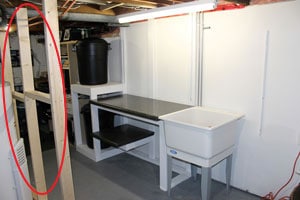
- If additional help is required, go asking – family unit, friends and local aquarists are all great.
One Tip is that fifty-fifty empty aquariums are heavy – Make sure yous have plenty bodies to acquit the aquarium.
75G Glass Tank = 100lbs Rough Empty Weight
120G Glass Tank = 190lbs Rough Empty Weight
210G Glass Tank = 350lbs Rough Empty Weight
You can rent suction cups and dollies from near Tool Rental Stores
One Week Before Moving Day
- All the packing supplies above should have arrived past at present
- Begin to assemble your moving supplies:
- Rubbermaid Bins are great for holding aquarium water – Ensure you accept plenty to hold all the h2o for the new aquarium! 200 gallon tank = 10x 20gallon trashbins
- Clean all storage totes and bins thoroughly!
- Get plenty pumps and heaters for each trashbin to mix and heat the new water
- Dr. Tims I and Only Nitrifying Bacteria Culture – Hither at Amazon.com (Fresh & Saltwater Versions)
- Ammonia, Nitrite and Nitrate Test Kits – I recommend Salifert – Here at Amazon.com
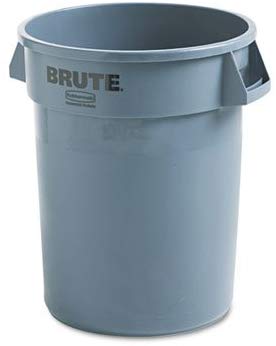
- Get some big fish nets – Makes catching fish so much easier!
- Collect former towels & Cardboard to walk on – You volition use lots!
- Collect salt and/or new RO/DI water filters for the initial fill
- Go new sand or gravel for your aquarium – Trust me its worth information technology!
You tin find a huge substrate choice Here at Amazon.com
To Calculate how much sand you lot volition need to employ Majority Reef Supply'southward Handy Calculator – Hither
- Ensure yous take all the necessary tools, materials, and construction supplies you will demand for the installation
Ii Days Before Moving Twenty-four hour period
This is where in that location can be several plans of assail depending on the new house situation. If yous have access to the new house this is what I recommend:
- If you are installing a new aquarium:
- Get it leak checked (Outside) installed, plumbed, and ready to go at the new business firm
- Fill the aquarium with the new substrate, fill information technology with water and plow on all the equipment
- Leak check all the plumbing
- Insert the recommended dose of Dr. Tims One and Only Nitrifying Leaner Culture
- If in that location is no new aquarium:
- Just prepare the new water for your one-time aquarium. In a Rubbermaid bin/s, get some water made up and become the heaters and pumps working to become it mixed and up to temperature. Place lids on the bins and so your water will be set up
- Make sure to continue it out of the way, but shut by to allow for easy aquarium installation
Dorsum at the old firm:
- Cease feeding all the fish
- Set upwards a long tabular array side by side to the aquarium – This will help to set up upward a production line for bagging and boxing fish, invertebrates, and coral
- Place downward towels on the table – It volition get very moisture during the bagging process
- Become all the packing supplies laid out in logical gild:
- Bags, safe bands, sharpie marking, insulated boxes, newspaper, heat/cool packs, packing tape, another sharpie marker
- Have several Rubbermaid Totes ready under the table to place the LiveRock in
- Take make clean cloths ready to cover the Live Stone
- Pack up all the aquarium supplies, food, tools, and medications that volition not be needed – Characterization the box
The Day Before Moving Day
- Confirm the moving truck and helpers are notwithstanding available
- Go all the paper-thin and towels downward and ensure the leave routing is all clear
- Practice a 25% water alter to assist remove whatever last traces of nitrates and ammonia
- Do a full console of water parameter tests
- Make a note of the current water parameters to ensure new water matches upon re-installation
- Check the new firm to ensure the new aquarium and/or h2o is ready – Temperature and salinity (if required)
- If firm moving day has already happened, ensure all the entry and routing is clear of obstructions and trip hazards

- Place cardboard and towels down on the route within the business firm to protect from drips and shoes
- Accept a proficient dinner and get a good dark's sleep! Tomorrow could be a long day!
On Moving Day
- Get up early and accept a adept breakfast!
- Begin to remove approx l% of the water into several v gal pails/buckets with lids – This water will go into the aquarium at the new house
- Begin by removing the aquascape rock or decorations
- Live Rock (if applicable) to be placed in totes. Advisedly comprehend with cloths dampened in aquarium water. Ensure each rock is stable in the tote to forbid coral impairment. A sheet of Egg crate on the base can help stabilize
- If required, insert estrus/cool packs into ZipLock bags and tape to the underside of the lid, identify lid on tote
- Take hold of fish and place similar species in the same handbag. Large fish in one bag. 2 smaller fish in one purse, max!

- Double purse and fill bag with air from the air pump. Secure bags with rubber bands
- Identify bags into insulated boxes, fill voids with newspaper
- If required, insert heat/cool packs into ZipLock numberless and tape to the underside of the chapeau, place lid on the insulated, and label the box and lace the box to ane side
- Repeat until all livestock is sealed away in boxes
- If a new aquarium awaits at the new firm, get going with fish and leave friends to dismantle the former aquarium, substrate, h2o, and dispose of – Don't forget to take the 5gal pails of old tank water to the new house!
- If the old aquarium is moving to the new house, at present is the time to give it all a actually expert clean while removing the erstwhile substrate and dismantling
- I find it easy if someone dismantles, passes the part to a helper and they clean and dry out it.
- Remove all remaining water and substrate and dispose
- Break downward the aquarium and pack into the moving vehicle
Take fourth dimension to have a break, eat, sit downward, and relax before driving to the new house! At that place is even so a long day still left to go!
- Upon arrival at the new house, if the aquarium is all prepare then great, if yous brought the old aquarium, go it installed, leveled, plumbed, wired and set for livestock.
- Check water parameters of new aquarium h2o or h2o in the Rubbermaid bin/south you prepared a few days before.
- Ensure the parameters match your quondam aquarium h2o EXACTLY!
- Remove Alive Rock from the totes and place on drinking glass bottom. Motility substrate out of the mode if its the new tank.
- Complete the aquascape and movement substrate into position around the Live Rock
- If doing this in the new tank, the h2o volition become cloudy!
- If it is the onetime tank, remove each cloth slowly as y'all build the aquascape
- Fill a spray bottle with old tank water and employ to dampen rock and coral if they outset to dry upwards
- Add the pails of old tank water to the aquarium (You may have to remove some h2o from the new tank. Plow off equipment before removing the h2o
- This old h2o volition aid minimize the mini nitrogen cycle that your aquarium will go through over the next week or and then.
Considering your livestock are going into a new surroundings I highly suggest you acclimate them just like you did when y'all bought them home for the first time.
If y'all need any tips on fish acclimation check out this article. It works for freshwater too, just leave out the salt parts:
How To Acclimate Saltwater Fish
- Begin to slowly acclimate each fish over 30 minutes and add together your livestock with the most aggressive and territorial fish going in final
- Reinstall the lights and canopy and go out the lights off for the rest of the day
- Exercise not feed the fish
- Add in a recommended dose of Dr. Tims One and Only – This volition assist kickstart the growth of the nitrifying bacteria
- Accept a thorough inspection of all the equipment, pipes, connections, and cables to ensure everything is working perfectly
Fire up the grill and requite all your helpers a well-earned steak and a few common cold ones!

The Day After Moving 24-hour interval
- Inspect all the equipment and ensure it is all running as it should with no leaks.
- Replace the mechanical filter media to help clean upwards the water
- Do a full panel of water tests, specially ammonia
I Tip is that your aquarium will probably go through a mini nitrogen cycle. Make certain yous begin to examination for ammonia, nitrite, and nitrate daily for the next calendar week or so to monitor any spikes.
- Keep the lights at 50% for today simply let them to ramp back upwardly ten% each day until back at your full setpoints. If lights are not dimmable, adjust the length of 'On Time' each mean solar day
- Do a very small feed to the fish and check every fish for signs of distress and appetite
Two Days After Moving Mean solar day
- Practice a ten-twenty% h2o change
- Replace the mechanical filter media equally the water should now be clear
- Begin to add some media back into your media reactors if you have them installed. Up to 50% works fine.
- Keep testing your water and monitoring for signs of distress
One to Ii Weeks After Moving Day
- Slowly begin increasing feeding and low-cal schedules back to their original amounts
- Remove any fish that show signs of distress and place them into quarantine
- Begin your regular maintenance routine
- Monitor for signs of loftier Nitrite or Ammonia and practise a water modify if values begin to rise also high.
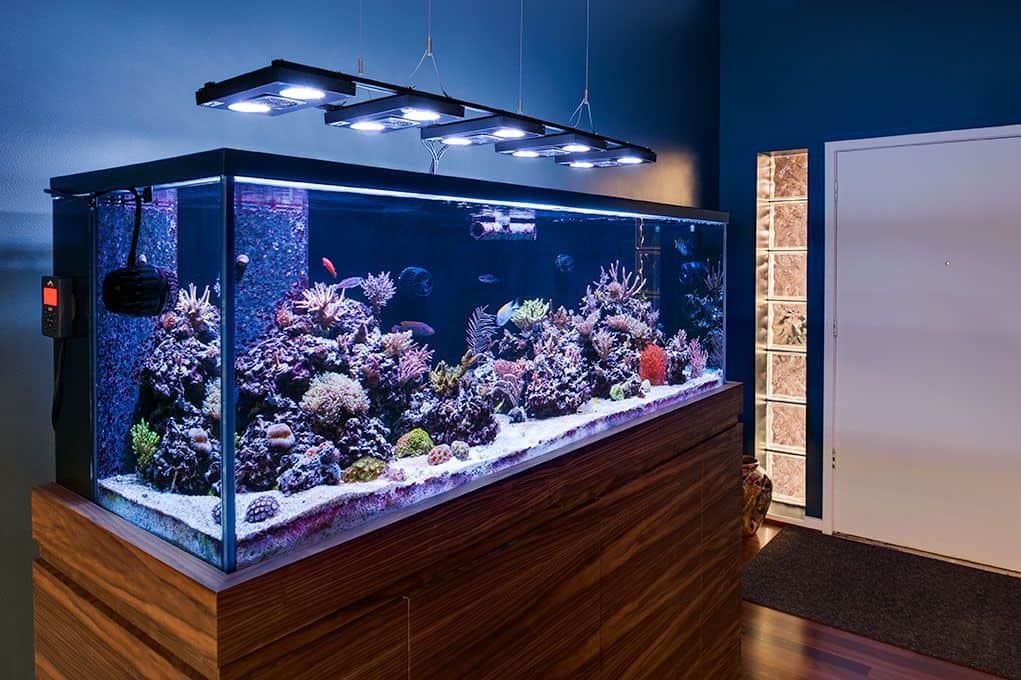
Hopefully, your aquarium motility will accept gone smoothly without too much stress and loss of livestock!
Moving Aquarium Across The Land
This is the hardest and most fourth dimension-consuming motility an aquarium tin can brand, just it tin exist done successfully by using a few methods and depending on your zipper to your livestock will depend on which method will all-time accommodate you
Method #one:
Selling all your livestock and only transporting the aquarium and equipment
Method #2:
Shipping all your livestock to a holding facility until you lot have moved, installed, and matured the aquarium then have them shipped back to you
Method #three:
Driving all the tank, equipment, and livestock across the land
To give you the very best resource we are going to discuss each method and so you tin can see which one may best fit your needs when it comes to moving time.
Method #1 – Selling
To nigh aquarists this is by far the easiest and most user-friendly fashion as the stress of moving house, particularly with a cantankerous country motility is right upwards there towards the height of life's most stressful times.
No matter if your aquarium is just a goldfish tank or a full coral reef, the easiest option is to pause it down many weeks or months ahead of the motility and save the money from the sales of your livestock to buy new.
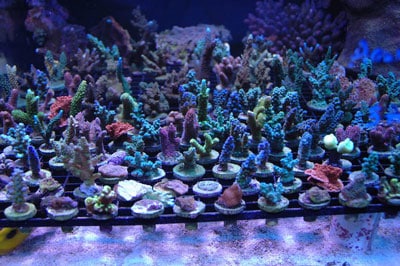
This is especially so when we are talking a mature coral reef aquarium! Selling frags or colonies of beautiful corals tin can presently turn that bank remainder into a fat piggy bank if you take the market around you lot to sell them to.
If this method is the one you wish to pursue, get fragging your corals and selling them months before the move. Practice NOT get out it until the last calendar week before the move unless y'all really want to get stressed!
This method is by far my best recommendation!
Mainly because information technology allows you lot to commencement off with a make clean slate when you get to your new domicile and it removes the risk of livestock fatalities during the motility.
You may wish to try a different aquascape, a unlike type of coral, heck you could even go a new, bigger aquarium because we are always wanting to upgrade. This method volition also prevent you lot from having to move a potentially big, heavy, and delicate aquarium!
Method #2 – Belongings Facility
If you already accept all of the livestock and/or corals you could e'er want and you lot tin can't bear to part with them, so shipping them alee to a holding facility or leaving them at a holding facility where you currently live are great options!
Aircraft your livestock to and from a holding facility can be washed fairly hands, just information technology's going to need to exist planned months in advance and it could toll you quite a scrap of money.
One Tip if this sounds like a viable option I highly recommend you practise this a week or two earlier moving your house and and so have them shipped to you a week or two later on the business firm is moved. Trying to do this on the aforementioned 24-hour interval or even a few days before moving your whole firm is just pure insanity!
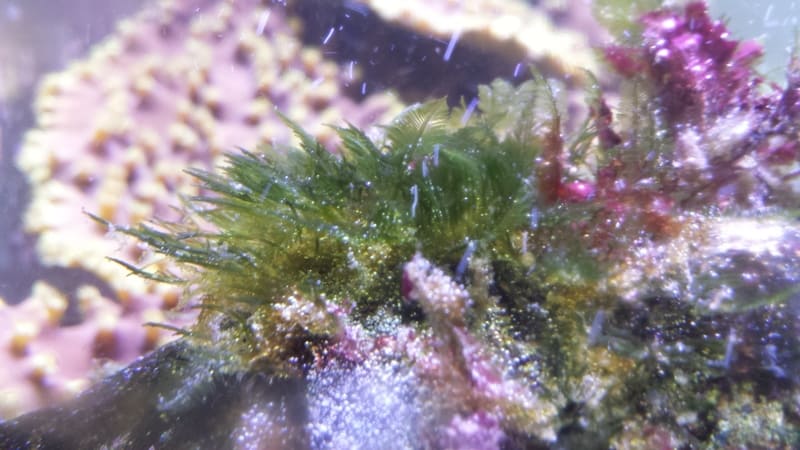
Method #2:
Several Months Before Moving Twenty-four hour period
The first thing is you demand to discover someone to ship them to who yous trust and has the husbandry standards you lot are happy with. At that place are several ways to find a holding facility:
- Telephone call some of the local (New Home), reputable fish stores in the area and talk to them about renting tank space. Even better is to get and visit them, audit them, see what they can offer you, and for how much and how long.
- Achieve out to the forums and see if any local aquarists may be able to help you lot. I have seen it many a time where beau aquarists are able to help each other out.
- If you lot have any aquatic friends where you currently live, see if they can hold your livestock for you, then ship it to you a few weeks after the move.
Each scenario is going to be different and so you will have to reach out and run across what options are available to you. Now its time to get together your packing supplies.
Method #ii:
One Calendar month Before Livestock Shipping Day
In one case you have confirmed the location of the holding facility and agreed on a shipping date you are going to need to become enough packing supplies to movement your livestock to the holding facility and provide them with enough supplies (and beer/wine/scotch) for them to transport them to you lot when required.
Here is a practiced list of recommended packing supplies:
- Diverse sized numberless or containers for your fish, invertebrates and coral frags – Double or triple bagging is a must!View Some Examples Hither at Amazon.com
- 4mil thick poly numberless recommended if Live Rock & coral being shipped
- Safety bands
- Insulated livestock shipping boxes.View Some Examples HERE at Amazon.com
- Clean cotton fiber cloths for wrapping Alive Rock
- Air Pump – Filling livestock bags with air volition increase the survival rate
- Paper for packing
- Labels – For livestock bags
- Sharpie Marker – For labels
- Shipping Labels from Shiping Carrier
- Packing Tape
- Heat/Cool Packs – Climate Dependant – Taped to the inside of the lid, do not allow packs to touch on whatsoever bags! – Just get the small ones, big ones create likewise much heat!
- Get some big fish nets – Makes catching fish so much easier!
Method #2:
2 Weeks Before Livestock Shipping Day
If you are shipping your livestock to a belongings facility shut to your new home you lot need to wait into the post-obit steps to ensure your overnight livestock shipments don't get left behind!

- Shipping company store opening times or pickup time bundled
- Estimated shipping cost and so you can budget – Same day or adjacent solar day
- Latest driblet off time at the shipping company for that shipping schedule – Plan for at least 1 hour before
- Timeline of how long it's going to take to pocketbook and pack every item to meet the aircraft deadline
- Perchance drive directly to the airport to save a journey in the UPS van – Time how long that journey and booking in fourth dimension will take – Go and speak with the cargo agent at the aerodrome
- Begin to reduce how much you feed your fish – Plan to completely cease feeding them 2-3 days before aircraft
- Get a few helpers lined upwards – It will make communicable and bagging far easier!
If you are leaving your livestock behind and a friend or store owner is going to ship them to yous I recommend yous exercise all these before you exit and take them accompany y'all or give them all the details to salvage their stress of aircraft your livestock!
Method #2:
Two Days Before Shipping Day
- Call the holding facility to confirm they are ready to accept your livestock
- Cease feeding all the fish
- Fix upwardly a long table next to the aquarium – This will assistance to fix a production line for bagging and boxing fish, invertebrates, and coral
- Identify down towels on the table – It volition get very wet during the bagging procedure
- Go all the packing supplies laid out in logical guild:
- Bags, safe bands, sharpie marker, insulated boxes, paper, oestrus packs, packing record, another sharpie marking
- Get all the aircraft labels filled out and ready
- Re-check your timeline to ensure you get out enough fourth dimension to catch, bag, box, and deliver the livestock to meet the shipper's borderline if you are shipping them across the country – Confirm no route construction or detours have popped upwardly!
Method #two:
The Day Earlier Shipping Day
- Practise a 25% water modify to help remove any terminal traces of nitrates and ammonia
- Take a skilful dinner and get a good nighttime'due south sleep! Tomorrow could be a stressful and long day!
Method #2:
On Shipping Solar day
- Become upward early and take a proficient breakfast!
- Begin to remove approx l% of the water to requite the fish less water to swim in
- Begin by removing the aquascape stone or decorations
- If you lot have a coral and Live Rock:-
- Advisedly cut with and Exacto-knife or Dremel (according to coral type) any coral growing between 2 rock pieces – Practise Non tear it!
- Place rock pieces in 4mil thick poly bags
- Carefully cover with cotton cloths dampened in aquarium water
- Place a few cupfuls of aquarium h2o in the bag
- Exist careful non to squash any corals on the stone against handbag sides/base
- Triple pocketbook each slice of Live Stone
- Secure each individual purse with rubber bands
- Grab fish and place similar species in the aforementioned pocketbook. Large fish in one purse. 2 smaller fish in one handbag, max!
- Double bag all fish and invertebrates and fill up pocketbook with air from the air pump.
- Secure bags with several rubber bands
- Place all bags into insulated boxes, fill voids with paper
- If required, tape heat/cool packs to the underside of the hat, tape the lid closed, and label the insulated box. Place the box to one side
- Repeat until all Alive Stone and livestock is sealed away in boxes
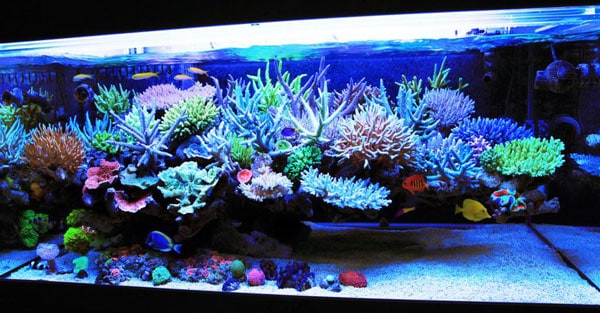
- Send someone to deliver or start delivering your livestock to the shipper or local holding facility
- If the facility is local, assistance them unpack, acclimate, tidy up and ensure they have lots of supplies ready to send to yous in a few weeks/calendar month
- Ensure you leave the required amount of booze/steak/souvenir cards to thank them for this monumental undertaking!
- If the quondam aquarium is going in the house move, now is the time to give it all a really expert clean while removing the old substrate and dismantling
- I find it easy if someone dismantles, passes the part to a helper and they clean and dry it
- Remove all remaining water and substrate and dispose
- Break downwards the aquarium and pack using styrofoam sheets and blankets to prevent impact breakage to the glass
- Label it well so anyone who is moving it knows exactly what information technology is and roughly how heavy and/or how many people are required to motility information technology!
Method #3 – Driving
Well if you wanted a challenge, yous certainly have one if you choice this method, but it can be done! I can tell you now that it is going to get stressful and packing up day, moving, and unpacking mean solar day are going to be some of the longest days in your life, but if your livestock merely has to go with you, then Buckle up for some more readin'!
When moving the house and a mature aquarium at the same time it needs some careful planning and almost ii teams of people. One team to pack upwardly the firm and one team to pack up the aquarium. It'southward going to get busy!
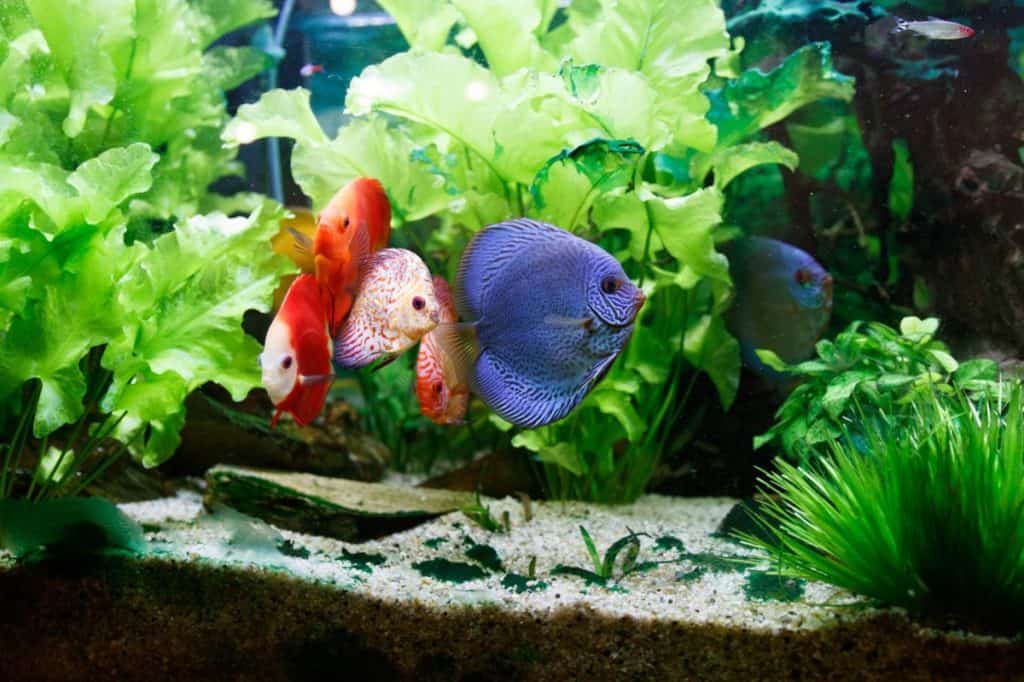
If you are moving a freshwater aquarium and then the job is ALOT easier, simply if yous are moving a mature saltwater aquarium teeming with corals, Alive Stone, invertebrates, and fish then the job is going to be a lot more involved!
To ship your livestock this way, the just this can really work is if you drive the aquarium stuff yourself, while the business firm and the residual of the family go via a moving company and driving/flying etc.
Depending on the size of the aquarium, you lot may accept to rent a Uhaul van or something like as you could take a dozen or more bins and totes containing all the livestock plus all the aquarium and equipment.
This type of move volition have some similar steps to all the moves talked about to a higher place simply with its ain caveats!
One of the all-time ways to transport fish, coral, and rock long distances is to create Livestock Send Containers or something similar. To help yous better empathize please watch this video I created to prove you how to easily make 1:
The number of containers you may demand will vary but each one will need to be heated and take air. You lot tin run several containers of a single air pump using a manifold like this i at Amazon.com, but remember the more air outlets you run off a single pump, the bigger the air pump volition need to exist.
As well, for a choice of suitable heaters from Amazon.com here is what y'all will need based on water book for each container:
| Water Volume | Heater Wattage | Recommended Heater |
|---|---|---|
| 2.5 Gal | 5 Watt | This Ane |
| five Gal | 15 Watt | This I |
| 10 Gal | 50 Watt | This One |
| xx Gal | 100 Watt | This I |
- If you are moving coral and Alive Rock I advise using Rubbermaid Totes (See Below) as they are like shooting fish in a barrel to place the rock in with a piddling water. If you have coral frags so a tote with a heater and a pocket-size water pump will ensure enough of flow for the times when the vehicle is not moving.
- If your vehicle or rental vehicle has a 110v outlet then take note of the maximum wattage you tin can run off information technology. My Minivan is 150 watt so make sure your containers are not going to max information technology out.
- 4x 2.5 gallon containers will use less wattage to run so 1x x gallon container. Be sure to check the wattage on the water and air pumps too!
- If your vehicle does non accept a 110v outlet and/or you demand more than wattage than the outlet can supply, you can buy an inverter like This One at Amazon.com to convert 12v from the car battery to 110v.
Method #3:
One to Two Weeks Before Moving Mean solar day
- Confirm the exact day for the move, ensure the moving visitor is booked for the aforementioned day! If you are renting a van, ensure that is booked too.
- Help will be required, get request! – Family, friends, and local aquarists are all great.
Ane Tip is that even empty aquariums are heavy – Brand sure you have plenty bodies to behave the aquarium!
75G Glass Tank = 100lbs Rough Empty Weight
120G Glass Tank = 190lbs Rough Empty Weight
210G Glass Tank = 350lbs Crude Empty Weight
You tin rent suction cups and dollies from most Tool Rental Stores
- Begin to assemble your livestock supplies:
- Rubbermaid Totes & Bins are slap-up for creating livestock transport containers
- Ensure your totes are large enough for the corporeality of livestock y'all have and you have enough of them
- Clean all storage totes and bins thoroughly!
- A heater and airpump/airline for each tote/bin
- A digital thermometer for each storage tote/bin – Relieves your feet!
- Dr. Tims Ane and But Nitrifying Bacteria Culture – Here at Amazon.com (Fresh & Saltwater Versions)
- Ammonia, Nitrite and Nitrate Test Kits – I recommend Salifert – Here at Amazon.com
- Get some big fish nets – Makes catching fish and then much easier!
- Collect old towels & Cardboard to walk on – You will use lots!
- Collect RO/DI water (san salt if required) set for the movement
- Get new sand or gravel for your aquarium – Trust me its worth information technology!
You lot can find a huge substrate option Hither at Amazon.com
To Summate how much sand you will need to use Majority Reef Supply'south Handy Estimator – Hither
- Collect empty table salt buckets or new 5 gallon pails from a hardware store – Clean thoroughly
- If you are planning whatsoever aquarium or equipment upgrades, ensure yous have all the supplies and new gear before you go out, or confirm they are already at the new house
- If any specialist tools, adhesives, or sealants are required ensure you have them all with you
- Begin to reduce the amount you feed the aquarium. Program to exist completely stopped feeding ii-3 days before moving twenty-four hour period
Method #3:
Three Days Before Moving Day
- Confirm with the movers and van rental over again
- Ostend your help is still available!
- Finish feeding the livestock
- Assemble all your moving supplies into the locations they demand to be at
- Exam all the water pumps, air pumps, and heaters to ensure they piece of work and they concur the correct temperature
Method #3:
The Day Before Moving Twenty-four hours
- Make up enough RO/DI water to fill several 5 gallon pails – This will be for partial h2o changes over the multiday journeying. Ensure you take a small heater and mixing pump if your aquarium is saltwater
- Begin to pack equally much of the equipment that is not required every bit you can:
- Food
- Medications
- Maintenance tools – Keep these handy
- Go all the tools required for aquarium disassembly close by – Ensure tool batteries are charged
- Pick upwards the rental van if possible
- Have a practiced dinner and get a good nighttime'southward slumber! Tomorrow could exist a long day!
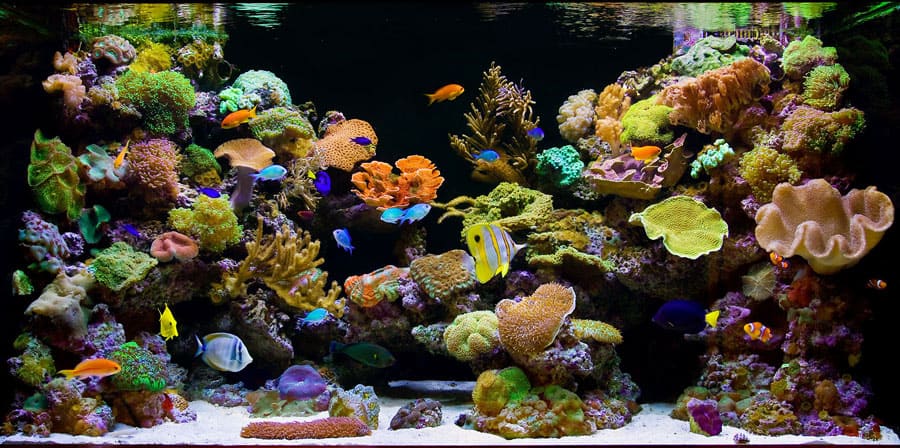
Method #3:
On Moving Day
- Get up early on and have a good breakfast!
- Park your rental van for the aquarium shut by, but not in the mode of the house movers!
- Get the power cords and inverter (if required) installed in the vehicle – Ensure They Work!
- Ensure your firm moving party is skillful and give your partner a buss! It could exist a stressful twenty-four hours!
Don't Blitz, Take Your Time, Be Methodical, Be Efficient
- Begin to remove approx 50% of the water into a storage bin/tote that is out of the way. This is for your livestock containers! A Python Vacuum is great for this as it has a long hose
You tin can detect one Hither at Amazon
1 Tip is to ensure there is a person on each end of the hose! Hoses pop out of containers very easily!
Here is how I recommend splitting upward your livestock set for send with some of the old aquarium water:
- Fish into buckets, containers, totes – They are going to need water, heaters, an oxygen pump, and lids
- Inverts into buckets, containers, totes – They are going to need water, heaters an oxygen pump and lids
- Ensure the livestock that is in the containers can tolerate each other – Use the chart below if it is a saltwater aquarium:

If you lot have a coral and Live Rock:
- Advisedly cut with an Exacto-knife or Dremel (depending on coral mankind type) any coral growing between two stone pieces
- Alive Rock go into one or several containers – Each container will need water, heater, and lid – Remember its heavy! Make each container manageable
- Loose corals into buckets or totes – They are going to demand water, heaters, and lids. A small h2o pump will aid in h2o move. Egg crate will assist them stay in place and can exist made into compartments to assistance support each slice while allowing water move. Zip-Ty's piece of work great for securing and creating sections – No Metal on Nothing-Ty'southward!
- Don't cram in also much rock and exist sure non to crush whatsoever coral
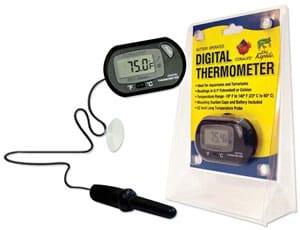
Find Them Here at Amazon.com
- Remove all remaining h2o from the aquarium – NEVER move an aquarium with water in information technology. The dynamic loads could crack the tank or impose loads on that could allow it to burst in the future!
- Take a few 5 gal pails of onetime aquarium water with yous to help seed the new installation
- Remove the sand or gravel and dispose of it. The amount of bacterial dieoff from disturbing the sand/gravel could cause a tank crash when re-installing! I have seen it a few times with owners that would not listen!
- Remove any the biological filtration media and place in a storage container with onetime tank h2o or a livestock container
- Install heater, pump, thermometer
- This ensures that all the beneficial nitrifying bacteria living in the filters will survive the move gear up for when nosotros need them at re-installation!
- Ensure the areas and walkways are clear of tools and equipment
- Move the aquarium, stand, and all additional equipment into the moving vehicle get-go. You will need admission to the livestock throughout the journey
- Get all the livestock totes into the vehicle and become them hooked up to power
- Ensure they are secure, working and cannot tip over
- Last into the vehicle you will need the post-obit:
- Some 5 gal pails of clean RO/DI water for water changes and common salt and measuring cup if required
- Heater and mixing pump if saltwater
- Jug for removing water for water changes
- I highly recommend you get a few spares of the following life back up items:
- Airpump
- H2o pump
- 12V Inverter
- Heater of each size
Method #3:
During Transport
Moving across a country the size of the U.s.a. tin accept days, especially in a rattly, diesel fuel moving van but providing your life support systems are woking and then you should have no problems.
Here are a few not bad tips to call up nigh when driving long altitude:
- The move of the vehicle volition help go along the water moving in the containers. The simply fourth dimension yous demand a very small h2o pump is for corals when the vehicle is parked overnight
- When parked overnight, run a power cord to the vehicle to power all the life back up equipment
- Ensure you lot have good fitting lids just with a hole in the center to allow for gas exchange
- Identify down cardboard and blankets on the floor of the vehicle if it is carpeted and transporting saltwater. Dried salt is a nightmare to make clean up!
- Every night or 24 hours completely remove the lids for a minute or two to really help exchange gas while checking on livestock wellness
- Any expressionless coral or animals, remove them instantly
- Exam ammonia levels daily in each container
- Practice small-scale water changes with the h2o (and salt if required) supplies y'all have. Just 10-15% is sufficient in each container. Ensure h2o parameters match!
- If possible try non to move in winter or the dead of summer. It makes the stress level go way up!
- If moving in wintertime or the middle of summertime relocate all the livestock bins into the hotel/cabin room and make sure information technology has ac
- Attempt and bulldoze the trip in 1 go using multiple drivers – Just be sure to check livestock while gassing up.
- Install a digital thermometer into the cargo area of the moving van to monitor the ambient temperature in there. – Too warm and you will cook the livestock
- If containers are beginning to go besides warm using a absurd patch like These From Amazon.com can help
- Identify 1 in a ZipLock bag and securely tape to the underside of each hat to assist combat the temperature rise
- Be sure to monitor using the digital thermometer installed in each container
Method #3
Destination Arrival
- Get paper-thin and towels downwardly to protect your new flooring and ensure the routing is all articulate
- Get all the livestock bins moved into the aquarium room only placed out of the style
- Ensure lots of room for installing the aquarium
- Plug in all the life support systems to the house power
- Exercise an ammonia test on every container and inspect livestock
- Do a 10-15% water change on any containers with ammonia reading annihilation higher up Zero ppm
- Remove any dead animals
- Bring in the containers of old and new water – Go the upward to temperature
- Brainstorm to make enough new water to completely fill the aquarium when needed – Get it up to temperature and salinity if required
The key here is to ensure the livestock is healthy before moving onto aquarium installation
Method iii#:
Re-Installation
- Get the aquarium and stand up installed and ensure it is perfectly level
- Go all plumbing connected and electrical extension cords etc neatly secured
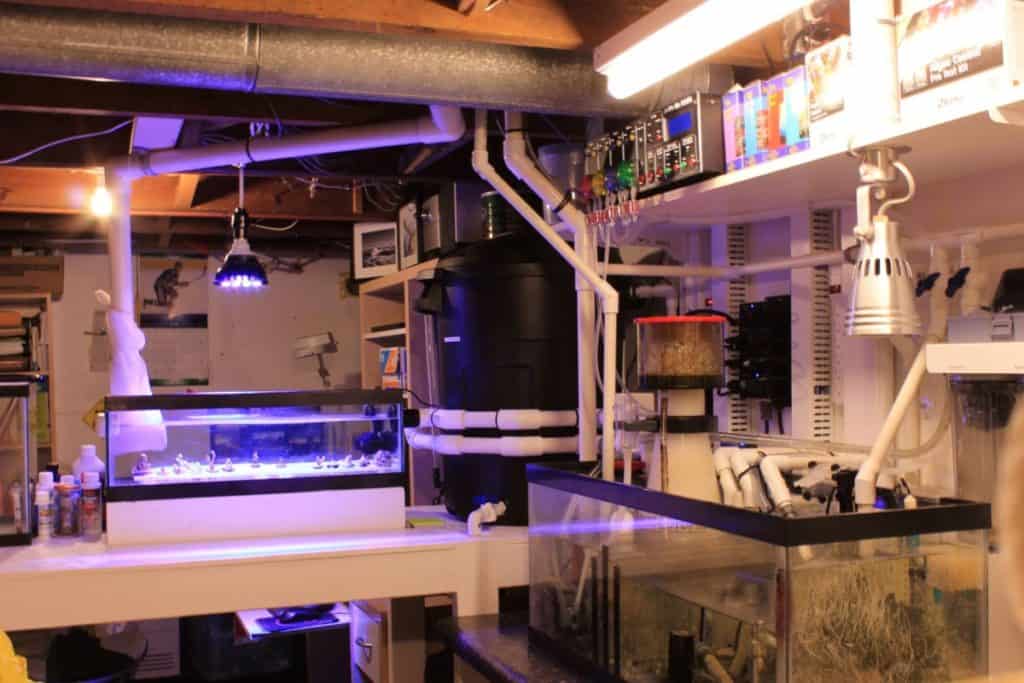
- Brainstorm to reinstall your aquascape with your Live Rock while placing in the NEW substrate – E'er place your rocks on the drinking glass and not on the substrate
- Once all your water is fix begin to fill the aquarium with the water you lot get-go removed from the aquarium and stored in the v gal pails
- As your aquarium begins to fill and covers all the equipment you lot can start to fire up the filtration and leak check
- Make full the aquarium with all the former water you have and have the remainder of the new h2o ready
One Tip is to pour your old tank h2o through a filter sock as information technology goes back into the aquarium. This will help remove any sediment from when it was outset removed.
- Once you are sure there are no leaks completely fill the system
- Run all the pumps, filters, and wavemakers to ensure everything is running as information technology should
- Add in a recommended dose of Dr. Tims 1 and Only – This will aid kickstart the growth of the nitrifying bacteria. Yous can find it Hither at Amazon.com in both fresh & saltwater versions
- If yous have media reactors installed leave them empty for today to allow the mechanical filter to remove the suspended sediment
- Cheque all the water parameters before adding your livestock
Because your livestock have been traveling for some time I highly advise you lot acclimatize them just similar y'all did when you bought them home for the first time.
If you need whatsoever tips on fish acclimation check out this commodity. It works for freshwater too, merely leave out the table salt parts:
How To Acclimate Saltwater Fish
- Brainstorm to slowly acclimatize each fish over thirty minutes and add together your livestock with the most ambitious and territorial fish going in last
- Reinstall the lights and canopy and leave the lights off for the balance of the twenty-four hours
- Do not feed the fish
- Have a thorough inspection of all the equipment, pipes, connections, and cables to ensure everything is working perfectly
Method #three:
The Twenty-four hour period After Installation Twenty-four hours
- Inspect all the equipment and ensure it is all running as it should with no leaks.
- Replace the mechanical filter media to help clean upwardly the water
- Do a full console of water tests, peculiarly ammonia
One Tip is that your aquarium is going to get through a mini nitrogen wheel. Make certain you brainstorm to exam for ammonia, nitrite, and nitrate daily for the side by side few weeks or then to monitor any spikes.
- Keep the lights at 50% for today but allow them to ramp back up 5% each day until back at your full setpoints. If lights are not dimmable, adjust the length of 'On Time' each day
- Practice a very small feed to the fish and check every fish for signs of distress and ambition
Method #3:
Two Days Subsequently Moving Solar day
- Supersede the mechanical filter media as the h2o should at present be articulate
- Begin to add some media back into your media reactors if you have them installed. Up to fifty% works fine.
- Go along testing your water and monitoring for signs of distress
Method #3:
One to 2 Weeks After Moving Twenty-four hour period
- Slowly begin increasing feeding and lite schedule dorsum to their original amounts
- Remove whatsoever fish or coral that show signs of distress and identify them into quarantine
- Begin your regular maintenance routine
- Monitor for signs of high Nitrite or Ammonia and do a water change if values begin to ascension besides loftier.
Hopefully, your aquarium move volition have gone smoothly without too much stress and loss of livestock! Moving a mature and healthy aquarium across the country is no easy feat and yous must look a few fatalities.
Wow, that was a long article! I hope yous managed to observe some good tips in there that I accept accumulated over many aquarium moves!
Planning and allowing enough time and coin for the move will see that it should exist a success. It's going to be a long and stressful experience but at that place are times when it just needs to be done!
Further Reading
If you plant this commodity helpful and would similar some more than information on topics applicable to your impending tank move I highly suggest the following:
- Aquarium Setup Guides & Costs
- Where Should I Place My Aquarium?
- 16 Tips For Creating Stunning Aquarium Aquascapes
- Fish Quarantine. How To Be Set In Minutes
- What Happens If Y'all Don't Acclimate Fish?

Moving Fish to a New Tank
Posted by: arreolaraides.blogspot.com


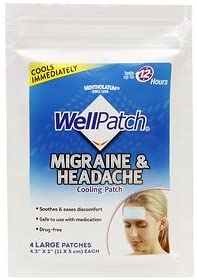

0 Response to "Moving Fish to a New Tank Updated"
Post a Comment